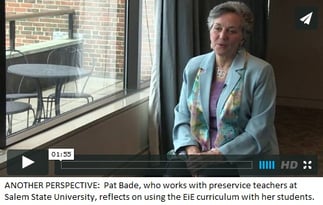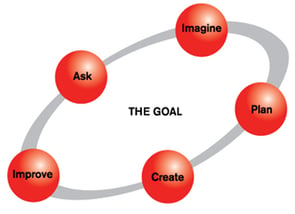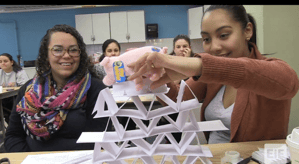Elementary teachers have to be ready to teach lots of different subjects, including science and (with the growing influence of the Next Generation Science Standards) engineering.
But most preservice elementary teachers take only a few science courses—and rarely any engineering. “Many students come to me with what I call ‘science baggage,’” says Leanne Avery, a science education professor at the State University of New York College at Oneonta. “They’re fearful of science. And if you mention engineering, they’re ready to run out the door!”
 To address this challenge, Avery integrated the Engineering is Elementary curriculum into her courses for preservice teachers on curriculum assessment and science methods. “I’m a big proponent of learning by doing,” she says. “EiE is so hands-on, user-friendly, and interdisciplinary, it really helps students build their comfort with science and engineering.”
To address this challenge, Avery integrated the Engineering is Elementary curriculum into her courses for preservice teachers on curriculum assessment and science methods. “I’m a big proponent of learning by doing,” she says. “EiE is so hands-on, user-friendly, and interdisciplinary, it really helps students build their comfort with science and engineering.”
EiE Teacher Guides Are Also College Textbooks
Avery works with about 60 future teachers each semester. Students purchase an EiE Teacher Guide as their textbook, and the class works through the entire unit. "My students really like the EiE binders,” Avery says. “We meet for three hours each week, and they can’t believe how fast those three hours go. We’re active and doing and building, and it’s hands-on.”
The prep lesson called “Tower Power” is often a break-through moment for Avery’s students. Included in every EiE unit, the activity (building a tower from index cards) introduces elementary students to a simple, age-appropriate engineering design process, or EDP.
 “We look at the five steps of the EDP (ASK – IMAGINE – PLAN – CREATE – IMPROVE) and I ask them, ‘For each of these steps, what did you do?’” Avery says. “As they fill in the blanks, there’s this wonderful moment when you see them realize, ‘Oh! Maybe I CAN do engineering!’”
“We look at the five steps of the EDP (ASK – IMAGINE – PLAN – CREATE – IMPROVE) and I ask them, ‘For each of these steps, what did you do?’” Avery says. “As they fill in the blanks, there’s this wonderful moment when you see them realize, ‘Oh! Maybe I CAN do engineering!’”
There are more break-through moments when students start their practice teaching. “Some of my students draw on EiE to create the lessons that they teach,” Avery notes. “It’s always exciting for them when they see how engaged the children are.”
Besides using EiE in her classroom, Avery adapts it for the summer workshops for in-service teachers that she co-leads with colleagues from Cornell University. And this fall, as part of a new and innovative program for preservice teachers, she’s taking her students (and EiE) on the road, holding her classes in a local rural school and in an afterschool program, rather than on campus.
Teach to Common Core Standards—and Still Teach Science
 “There are so many reasons to use EiE with preservice teachers,” Avery says. “It allows them to practice, engage in, and experience differentiated instruction—which is important because they’ll have students who learn in different ways. It’s a great curricular model of an interdisciplinary unit. And it shows students that you can attend to academic standards yet still use diverse pedagogical practices."
“There are so many reasons to use EiE with preservice teachers,” Avery says. “It allows them to practice, engage in, and experience differentiated instruction—which is important because they’ll have students who learn in different ways. It’s a great curricular model of an interdisciplinary unit. And it shows students that you can attend to academic standards yet still use diverse pedagogical practices."
With New York State placing strong emphasis on the Common Core State Standards for mathematics and English Language Arts, Avery sees local teachers hard-pressed to fit science into the school day—let alone engineering. “I visit six to ten schools a semester, and I rarely see science taught,” Avery says. “If I DO, I rarely see students engaging in science by doing.” Avery hopes her next generation of elementary teachers will change that.
Engineering is Elementary is a project of the National Center for Technological Literacy at the Museum of Science, Boston.








